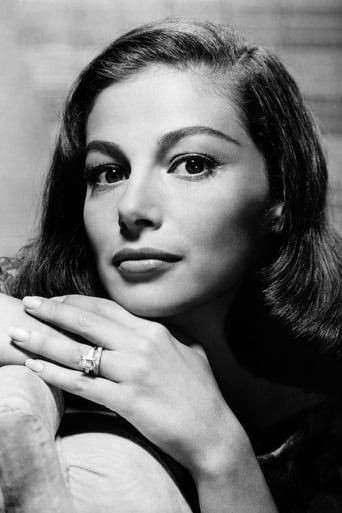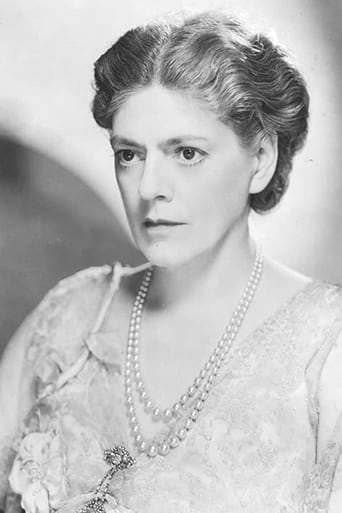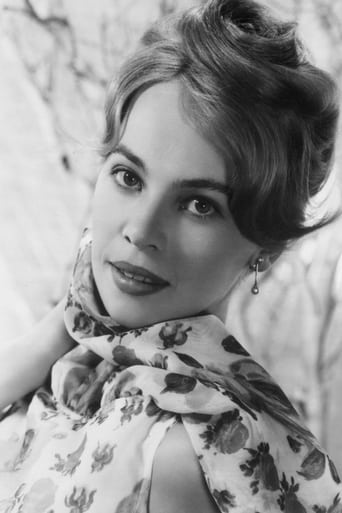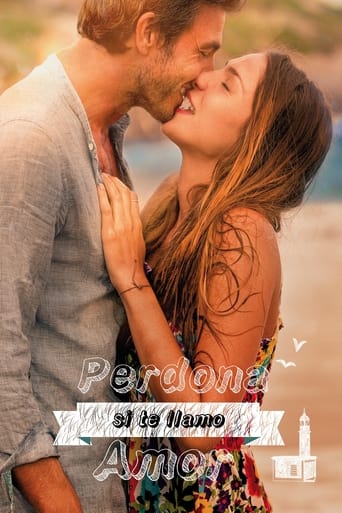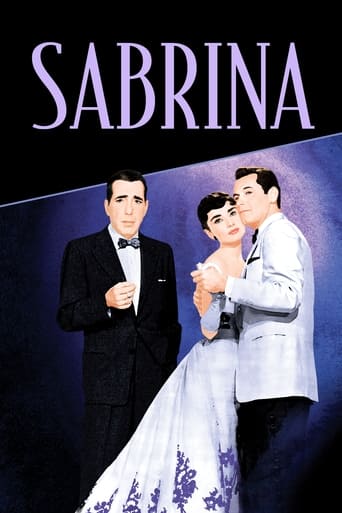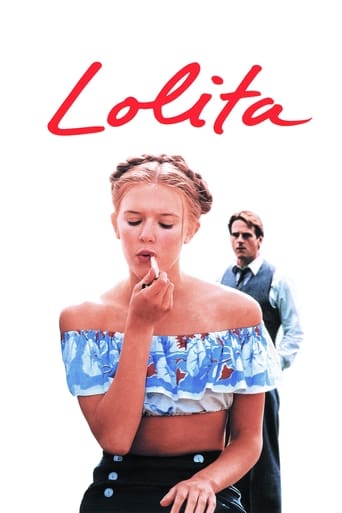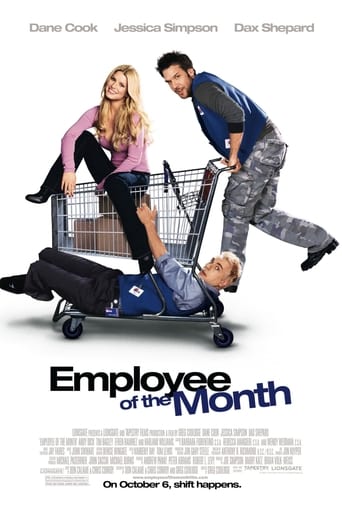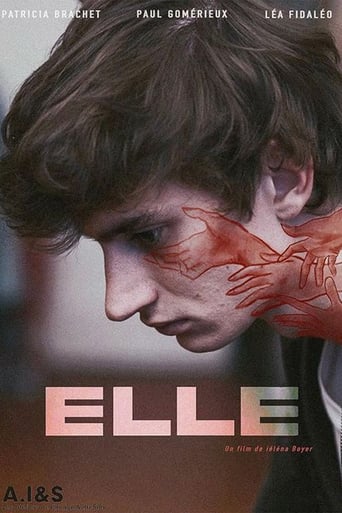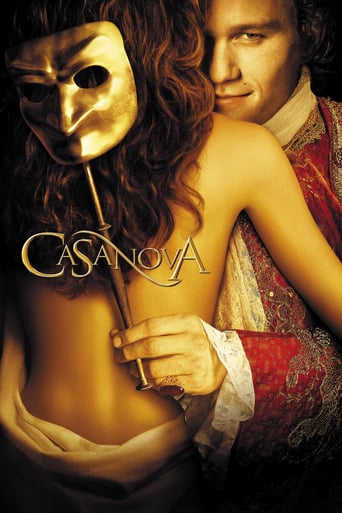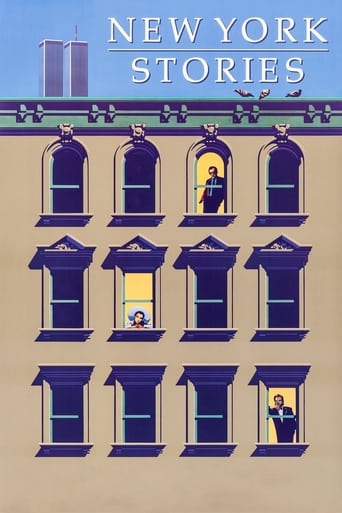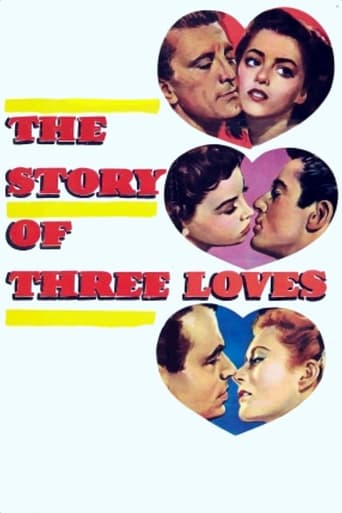
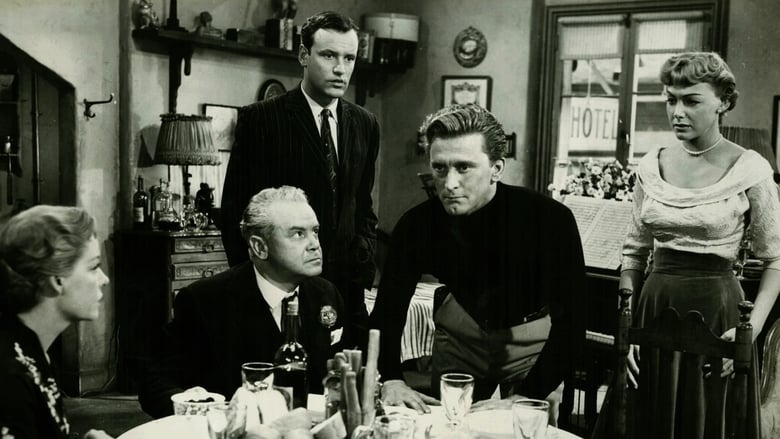
The Story of Three Loves (1953)
Passengers on an ocean liner recall their greatest loves.
Watch Trailer
Cast


Similar titles
Reviews
I'm a very sentimental person, as my wife would tell you, and typically enjoy an old-fashioned love story on film, but this film struck me as odd. During the intro to the film I was intrigued--three love stories woven together on a ship. I thought that we would see how the characters from each story interacted on the ship, and how that interaction was both influenced by the love stories that came before, and how that interaction affected the lives of the individuals going forward.But that wasn't the case at all. The ship serves as nothing more than a vehicle for introducing the characters from each vignette, and the characters never meet or interact. And the vignettes are so disparate in concept that it makes the whole film seem uneven. Consider that the first story is about ballet and heart attacks, the second about witches and wishes, and the third about suicide and circus trapeze artists.And within the stories there were issues that nagged me. James Mason was great in the first vignette, until the young lady begins dancing in his studio. Then his comments/critique of her dancing--"That's it, that's it, higher, higher..." seemed silly. It worked much better once he was just quiet and the dance became the focus. Otherwise, his comments broke the magic. And in the final segment on the trapeze, the American hiring circus acts goes from "How can I buy an act unless I see it EXACTLY as it is to be preformed for audiences?" to "I'll pay ANYTHING for this act!" in one short minute. Add to that that none of the American actors portraying french men and women in this vignette have a french accent (I suppose that is better than a bad accent) while the non-American actors do have accents, and it just comes across as odd. This accent issue is also amplified by the fact that the second vignette of the young boy who gets his wish to be a man has an underlying storyline about speaking french properly! So we go from one extreme to the other throughout the film.I can't help but believe that this film was three story ideas none of which had enough depth or breadth to carry a film on their own, and the ship deck mechanism was invented in order to pull together some less than perfect film ideas.
(Spoiler warning: Please don't read this unless you have already seen this movie or don't care about spoilers.)It's an anthology of three stories. In the first one, a ballet dancer is forbidden to dance because she has health problems. But when a famous ballet director (who doesn't know about her health problems) asks her to dance for him because he seeks inspiration in order to improve his latest production, she can't resist the temptation... It's the story of a love that can't be fulfilled. I liked James Mason as the ballet director, and I was impressed by Moira Shearer's dancing, although I'm not generally a great fan of ballet dancing. And I love the music they used for the soundtrack, the 'Rhapsody on a Theme of Paganini' by Sergei Rachmaninoff.Next in sequence there is the story of a teacher (played by Leslie Caron) who hasn't known love yet. It's in the style of a fairy tale. Young Tommy (played by Ricky Nelson), the boy she teaches, becomes an adult for a few hours (through witchcraft). He meets his teacher and they fall in love, but when his spell as an adult is over, their love has to end. But the teacher has changed, and when she later meets another man, she might find lasting love... So it's the story of a love that might be fulfilled. I liked both the story and the actors.The last story makes the sequence complete. It's the story of a love that is fulfilled. I liked Kirk Douglas very, very much; I found him very convincing as Pierre Narval, a disillusioned and retired aerial acrobat. I also liked Pier Angeli; she plays Nina Burkhardt, a woman who is so disillusioned she tries to commit suicide. But she is saved by Pierre, who later asks her to become his partner for his comeback. They are both haunted by memories of their past; Nina thinks she is responsible for the death of her husband, and Pierre probably feels he is responsible for the death of his former partner, although he says it was an accident. Pierre trains Nina. They fall in love, but then there is a very dangerous stunt they have to perform without a safety net...I liked the third story best. The others weren't as good in my opinion, but I have still given ten points because I think that somehow (forgive the worn-out phrase) the whole is more than the sum of its three parts. I think the order in which the stories are told is well chosen for a sentimental love movie.I think if you like the genre, this movie is well worth a look.
Several years ago, when I first saw this movie, I felt that it was melodramatic with awkward dialogue and clumsy direction, and not worth my time, except for the dancing segment with Moira Shearer and James Mason ("Jealous Lover"). After this recent viewing, I have a better appreciation of the finished product and wonder at the curious division of directors, Minnelli and Reinhardt, and committee of script writers, which may account for the structural and dialogue flaws in the film. Throughout the movie I had the curious feeling that the influence of the great team of Michael Powell and Emeric Pressburger was haunting the producion. Both script and direction fall short of their work, such as "The Red Shoes" or Stairway to Heaven." Yet on this second viewing I still felt it worth my time. First, the casts are well chosen and the camera loves them, especially the three female leads: Shearer, Caron and Angeli. One cannot find three more gorgeously photogenic and sensitive faces captured by Hollywood and its lenses than these -- and without excessive makeup. Being English, French and Italian (in that order), they also embody the international strength of post-war Hollywood, and are strong complements for the male leads, Mason, Granger and Douglas, all of whom made their careers in America (Mason was born English, I believe). These three leading ladies were certainly chosen for their youthful radiance and sensitivity, and the luminous close-ups plus the saturated color and lush music by the great Rozsa (who appears as the conductor in the first segment) lend a baroque richness to each of the segments reminiscent of Visconti's "Senso," or possibly even "Il Gattopardo."Second, the camera work and lighting are excellent, both subtle and dramatic at the same time, fully enhancing the flashback aspect and sense of fantasy in all of the stories and revealing the delicacy and individuality of the three women, not to mention the great Agnes Moorehead in the first segment. The delicacy of Shearer, Caron and Angeli with the differences in each of their coloring and bone structure, contrasts dramatically with their respective male leads, the forceful articulateness of Mason (given an incredibly weak script stilted and overwrought when compared to P & P's dialogue for Lermentov in "Red Shoes"), the boyish tenderness of Granger in the second segment, and the snappy personality of Douglas in the high wire segment.In the latter, which other reviewers seemed to like the least, I found Angeli's combination of vulnerability and inner strength very moving, all of the emotion held back, but pouring out of those great expressive eyes. Her subtlety provided the proper foil for Douglas's aggressive, almost animal energy and line delivery. I am not by any means a fan of Douglas (except for his "Lust for Life"), but I liked him in "Equilibrium," and was impressed that most of the aerial stunts seemed to have been done by him. Certainly the circumstances of the war that led to Angeli's suicide attempt in the story lent a depth to the plot that was very much of the time and may be difficult for Americans to understand today. However, Europeans were still deeply affected by the war even in the mid-fifties (see "Act of Love," another film of Douglas's). What each of the female stars gave to the film, as the focus of the "three loves" of the title -- Shearer in her role as a ballerina with the exquisite choreography by Frederick Ashton (celebrating the centennial of his birth this year); Caron, in an early non-dancing part actually using her French in the dialogue if not in the poems by Verlaine; and in Angeli cast as a victim of the war-- was a sense of authenticity and genuineness. I find these qualities very much lacking in the majority of American films, certainly those made by recent directors. One final thing I liked about "Equilibrium" was showing how Douglas trained Angeli step by step in the high wire act to build up her strength and courage. One doesn't usually see this in a film. It also looked as if Angeli did her own stuntwork. Even if she didn't, it was effectively shot.In all, a film worthy of renewed viewing. Of four ****, I give three and a half
See the story of three strangers as they cruise the Atlantic and remember what it's like to fall in love.The first stars Kirk Douglas as a circus artist. A little slow for me. The second has James Mason as a harsh ballet choreographer. Will he choose love over his career?The third sees a pre-Tom Hanks Big really get to the heart of the matter. It's my personal favourite. Leslie Caron is a born romantic who falters having to teach a precocious brat. This one leaves you with a warm heart. Rent (or buy) this but skip the circus story. The other two will cheer up the hardest viewer. Don't expect Hollywood all the way. It's got enough of a European flair to keep it interesting without making it heavy or difficult to follow.Enjoy.


